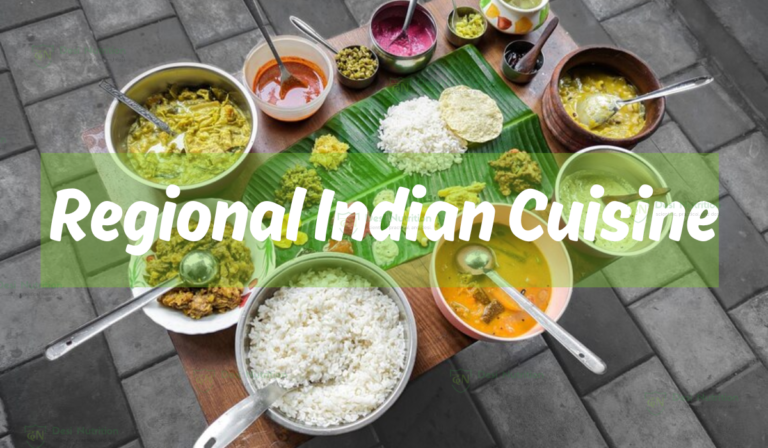India is a vast geographical country with a rich culture and heritage. The rich culture is the source of many traditions which has given rise to multiple traditional cuisines. Indian cuisine is also one of the most famous and healthy cuisines from Asia. In this article, we will be exploring regional Indian cuisines.

India is well-known for its diversity, be it in cultures, geographical gems or spice-laden dishes. From north’s rajma-chawal, to South’s Idli-sambar, to west’s fafda-jalebi, to east’s fish curry, you will find variety in each dish with its root in its culture.
Indian food is often associated with deep-fried, oily, and spicy food. But if we look into the traditional ties of each dish, Indian cuisine is actually healthy and nutrient-rich. The traditional Indian dishes use natural food sources including both plant and animal, herbs and spices, and even traditional methods of cooking which makes the dishes healthy for you.
We bring to you the world of regional Indian cuisines from hearty, spicy-laden dishes of the north to the lighter coconut-infused fare of the south. The dishes are a treasure—a treasure of flavors, textures and nutritional benefits. So let us dive into the realm of various regional Indian cuisines:
1. North Indian Cuisine: Rich, Bold, and Nutritious

The North Indian region constitutes Punjab, Haryana, Uttar Pradesh and Jammu & Kashmir, Uttrakhand, Himachal Pradesh. All these states use a variety of food sources including dairy, wheat, and legumes. Every state has its own traditional cuisine and you would be amazed how different they are from each other even after using the majority of the same ingredients. The northern part of the Indian subcontinent is vegetarian and majorly uses plant-based ingredients to cook traditional meals. Around 71% of the population in the north consider themselves vegetarian.
Key Ingredients:
- Whole Wheat: North Indian meals revolve around rotis and chapatis made from whole wheat. Whole wheat is rich in B vitamins and minerals like magnesium and iron. They help to support digestive health and maintain energy levels.
- Legumes: Legumes and lentils like chickpeas, and kidney beans are staples in North Indian dishes. They contain protein, fiber and antioxidants which make them a good option of food for heart and digestive health.
- Yogurt and Paneer: Dairy also makes up the major part of northern cuisines. Dahi, paneer and milk are excellent sources of calcium and vitamin D which is good for your bone health. Dairy is a key component in northern cuisine.
Healthy Dishes:
- Rajma (Kidney Bean Curry): Rajma is not just people’s favorite but also nutrient dense ish which has high content of protein and fiber. The plant-based dish helps to regulate blood sugar level and keep you feeling full for longer times.
- Sarson Ka Saag and Makki Ki Roti: A delicacy in Punjab, sarso ka saag and makki ki roti is a winter special. The dish, saag, is made of mustard greens and served with corn flour flatbread. Mustard greens are rich in vitamin A, C, and K which are known to have anti-inflammatory properties.
- Tandoori Dishes: Tandoori cooking involves marinating meats or vegetables in yogurt and spices and then cooking them in a clay oven. This method retains nutrients while minimizing the use of oil, making it a healthy cooking technique. Tandoori chicken or grilled vegetables are great options for a lean, protein-rich meal.
2. South Indian Cuisine: Light, Flavorful, and Nutrient-Rich

South India, constitutes states of Tamil Nadu, karnataka, Kerala, ANdhra Pradesh and Telangana. The dishes that come from the South region of the Indian subcontinent comprises light, rice-based dishes, lentils and extensive use of coconut oil. Rich in flavors and extensively balanced dishes are a part of South Indian traditional dishes.
Key Ingredients:
- Rice and Lentils: Rice and lentils make a prominent part of South Indian cuisine. Rice is a rich source of carbohydrates and lentils are a source of protein and other essential amino acids.
- Coconut: Coconut is the main ingredient of south indian traditional dishes. It is used in the form of milk, oil or as freshly grated coconut. Coconut oil contains medium-chain triglycerides (MCTs), which are easily digested and used by the body for quick energy. Coconut is also rich in fiber and antioxidants.
- Fermented Foods: The batter of rice and lentil is fermented for dishes like idli dosa. This increases their nutritional value by improving digestion and gut health.
Healthy Dishes:
- Idli and Sambar: Idli sambar is a popular dish in South India and it has traveled to other regions as well. Idlis are steamed cakes made from fermented rice and lentils. This makes them lighter on your gut and digestive health along with offering a variety of nutrients. It is paired with sambar, a vegetable and lentil stew making it nutrient-dense. The meal is rich in protein, fiber and vitamins.
- Avial: Avail is a kerala’s delicacy which is a curry made of mixed vegetables cooked in coconut and yogurt. It is low in calories and packed with antioxidants, vitamins and minerals.
- Rasam: Rasam is a tangy, spicy soup made with tamarind, tomatoes and spices. It is a staple in south India which aids in digestion and is low in calories. Rasam is rich in vitamins C and A. This tangy, spicy soup made with tamarind, tomatoes, and spices is a South Indian staple. It aids digestion and is low in calories while being rich in vitamins C and A.
3. East Indian Cuisine: Simple, Fresh, and Nutrient-Dense
The picturesque region of India, Eastern India comprises states like West Bengal, Odisha, Assam, and other northeastern states. The traditional food of East India is mostly animal-based and is simple in many ways. The emphasis in Eastern cuisine is on fresh and seasonal ingredients. The use of fish, mustard oil, and leafy greens makes the cuisine of this region particularly heart-healthy and nutritious.
Key Ingredients:
- Fish: Bengal and Odisha, particularly, are the two regions in Eastern India which emphasize on the use of fish prominently in their dishes. Fish is the source of lean protein and is rich in omega-3 fatty acids. Omega-3 fatty acids are essential for your heart health, brain function and helps reduce inflammation.
- Mustard Oil: Mustard oil is one of the most common ingredients used in cooking Eastern traditional dishes. It is high in monounsaturated and polyunsaturated fats. It also contains omega-3 and omega-6 fatty acids, bothe known to improve cholesterol levels; hence improving your health.
- Leafy Greens and Vegetables: The use of seasonal leafy green vegetables like pumpkin, radish, and spinach makes Eastern cuisine packed with nutrients. Such dishes rich in nutrients like fiber, vitamins, minerals, and antioxidants promote digestion and protect against chronic diseases.
Healthy Dishes:
- Steamed Fish (Bhapa Maach): Steamed fish is a Bengali delicacy which involves steaming fish with mustard paste, yogurt and minimal spices. The meal is rich in protein, fat, and omega-3.
- Chorchori: Chorchori is a mixed vegetable dish which uses minimal oil and a variety of seasonal vegetables. The meal is packed with nutrients and is in calories.
- Pakhala Bhata (Fermented Rice): Pakhahla Bhata is a traditional dish from Odisha. It is fermented rice served with yogurt or vegetables. The dish is good for your gut health and also helps to cool down your body especially during hot summer days.
4. West Indian Cuisine: Bold Flavors and Nutrient-Rich Ingredients
Western Indian cuisine comes from the states of Gujarat, Maharashtra and Rajasthan. Each state offers their own unique blend of flavors. The cuisine is mostly vegetarian and focuses on grains, legumes and vegetables making it naturally nutrient rich.
Key Ingredients:
- Millets: Western Indian diets often include millets like jowar (sorghum), bajra (pearl millet), and ragi (finger millet). These ancient grains are gluten-free, rich in fiber, and high in essential minerals like calcium and magnesium.
- Legumes and Pulses: Pulses like moong dal and black-eyed peas are a common source of protein in the western Indian diet. They are high in fiber and help regulate blood sugar levels, making them ideal for diabetics.
- Spices and Herbs: Western Indian cuisine is known for its use of digestive spices like cumin, coriander, and asafetida. These spices not only enhance flavor but also aid in digestion and metabolism.
Healthy Dishes:
- Kadhi: A yogurt-based curry made with chickpea flour, kadhi is light and rich in probiotics, supporting digestion and boosting immunity. It’s often served with rice or roti, making for a balanced meal.
- Thepla: A Gujarati flatbread made with whole wheat flour, fenugreek leaves, and spices, thepla is nutrient-dense and rich in fiber. The addition of fenugreek helps regulate blood sugar levels and provides a good dose of iron.
- Rajasthani Dal Baati: This traditional dish from Rajasthan is high in protein and fiber. The baati (wheat balls) are baked, reducing the use of oil, and served with a flavorful dal (lentil stew), making it a balanced and hearty meal.
5. Northeastern Indian Cuisine: A Fusion of Fresh and Organic
The northeastern states of India offer a unique culinary tradition that is less oily and spicy compared to other regions. The cuisine is simple, with a strong focus on organic and seasonal produce, fermented foods, and herbs. It is naturally low in fat and high in nutrients.
Key Ingredients:
- Bamboo Shoots: Commonly used in northeastern cuisine, bamboo shoots are low in calories and rich in fiber. They are also a good source of potassium and antioxidants.
- Herbs and Fermented Foods: The use of fresh herbs like cilantro and fermented ingredients such as fermented soybeans (axone) add both flavor and nutritional value. Fermented foods, in particular, are excellent for gut health.
- Lean Meats: Unlike other parts of India, the northeast consumes more lean meats like fish, chicken, and pork, often cooked with minimal oil and spices, making the meals high in protein and low in fat.
Healthy Dishes:
- Steamed Fish with Bamboo Shoots: This dish, common in Assam and Manipur, involves steaming fish with bamboo shoots and herbs. It is rich in protein and essential nutrients while being low in calories and fat.
- Black Rice Salad: Black rice, a specialty of Manipur, is rich in antioxidants, fiber, and iron. Paired with fresh vegetables and herbs, it makes for a nutritious and filling meal.
- Eromba: A Manipuri dish made from boiled vegetables mashed with fermented fish and chili, eromba is a low-fat, high-fiber dish that supports digestion and overall health.
Frequently Asked Questions
What is regional cuisine in India?
Ans. India is a diverse country with 27 states, each state having its own culture and tradition. A regional cuisine means a cuisine that belongs to a particular region, be it North, east, West or South. A regional cuisine is categorized based on the availability of ingredients, and the methods of cooking. For example, in North Indian cuisine the use of lentils and whole grains is more than in other regions of the country.
What is India’s national dish?
Ans. India does not have a national dish because of the diversity in its cuisine. India is home to at least 9 different cuisines based on different regions.
Which state is famous for food in India?
Ans. There is no one state which is famous for food in India because you can step in any state or city and you will find mouthwatering dishes all around you. Be it street food or traditional dishes, you will experience a blend of cultures and flavors in every dish. Be it Punjab’s butter chicken Rajasthan’s dal-bhati, Bengal’s rasgulla, or sandesh, every dish has a story to tell. The dishes are packed with nutrients when made from authentic ingredients and traditional cooking methods.




